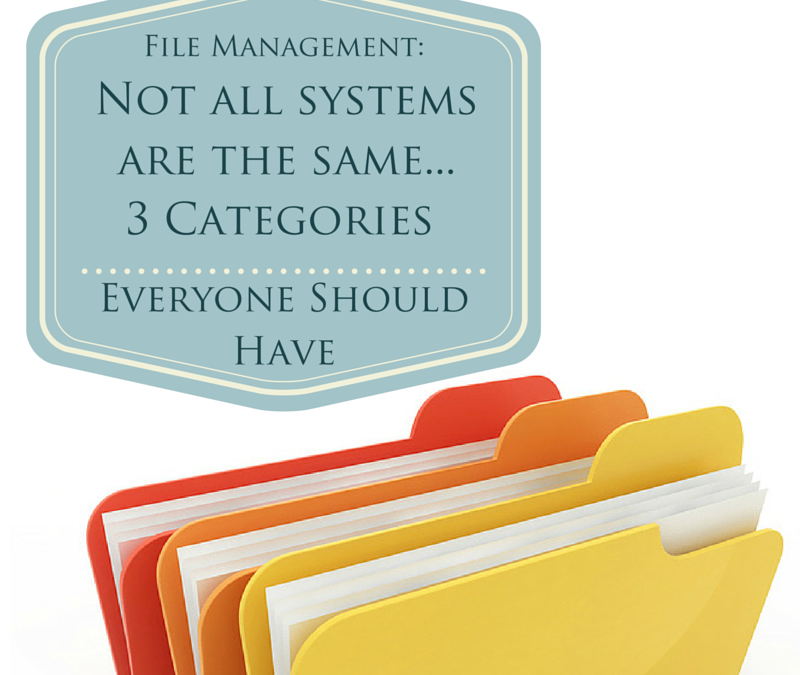I know so many people who feel like they’re drowning in paperwork. The piles and files seem never-ending, and as I know from working with my clients for many years now processing the papers feels like it will take an eternity.
However, I have written in the past about the simple system that I have successfully used myself and with hundreds of clients to move through those paperwork mountains: BARFT (which stands for Bills, Actions, Read, File, Trash.)
Today I want to dig a bit further into the FILE category, and talk about how not all files are created equal, and there may be a benefit to rethinking your filing system to help you keep only what you need immediately at hand.
I believe that every person or household would benefit from segmenting their files into three types, so let’s make things simple and talk about those three basic types of files:
Old: Archive Files
These are the files that are full of your old records. In my house I would include my financial records from previous years which are kept for tax purposes, past clients files, and any paperwork that’s hanging around for purely sentimental reasons. Archive files serve a purpose in storing our history and ensuring we’re covered for the “just in case” moments (like an audit or former client returning) or the nostalgia moments when we wander through our past.
However, what’s important to remember is that these files are essentially “done.” We are no longer referencing them daily or weekly, and therefore it’s best to not have them gumming up our active spaces and storage. In other words, get them out of your office file cabinet, and out of your main living space. Find a dry place where these archives can hang out in a basement, attic or remote closet.
Having recently visited St. Petersburg, FL, you could say that that space is the paperwork version of heaven’s waiting room because it’s just waiting there until you decide you’re ready to recycle, shred, or trash it. There will be a very small percentage that might get pulled out and viewed again for a specific purpose, but most of it is just waiting to move along.
New: Active Files
These are the files that do belong in your filing cabinet because you’re still interacting with them regularly… even if it’s just once a month to pop the newest bank statement into the folder. These are the current year’s financial statements, credit card bills (after being paid), insurance documents, medical files, car records for your current car.
This folders are relevant to your current life and are either actively receiving new contributions each month or are pulled out for occasionally reference a few times a year (like when you take your pet to the vet.) Basically, these are the files that will eventually become either archive or trash, but they are still active enough to deserve prime real estate space in your home or office.
One of the keys here is to do a yearly purge of these files and make sure nothing really old which should be archived is clogging up your regular works. I typically do mine in January after receiving all the year end statements to make room for the new year’s paperwork. That keeps my files (and file drawer) much easier to manage and interact with. No wrestling overweighted drawers full of a decade of archive papers.
Hot: Project Files
The first two categories will probably feel familiar to you or make sense as a way to unload your overburdened filing cabinet. However, this category of Project Files might inspire a bit of a “huh?” Project files are related to your very active work and are referenced frequently while you are actively engaged in a particular project.
Let me give you an example… my husband and I decided that it was time to replace our 10-year-old car recently. So, I’ve spent a lot of time doing research, test drives, negotiating offers, etc. While we were considering our options and making decisions this paperwork has been reviewed and carried around for several weeks (technically a few months since we first started considering the replacement last November.) But, I didn’t create a permanent folder for this research in my active filing system. Instead I created a project folder for New Car Research which has lived in my project file shelves where it can be pulled in and out quickly and easily as needed from day-to-day.
I’m picking up our new car today, and therefore almost all of the research paperwork will go straight into the recycling bin. I will create a more permanent “active file” for our new Honda Accord where I can store the lease paperwork and maintenance records, but most of the rest of this stuff will become immediately unnecessary. That’s the beauty of a project file… by separating them out from your main active filing system you make them both more accessible and easier to purge once the project is complete.
Occasionally, project files will become either active or archive files, but at that point you can think through exactly when you might ever need this paperwork again and only keep what’s most relevant. Many of my project files get dumped entirely when the project is complete, or occasionally I’ll just scan a few of the most important items to Evernote or Dropbox.
This project file system allows me the benefit of both keeping the really hot files within easy reach and avoids unintentionally adding a whole bunch of temporary clutter to my permanent file drawers.
Next Actions
For more info about active vs. archive files, or about setting up a project file system for yourself you can read some of the other posts I’ve written on these topics in the past.
Hopefully, this article has given you some clarity and inspiration to start tackling your paperwork challenges or updating your filing system to make it even easier for you to find what you need quickly and immediately. Since we all know someone who’s frustrated by paperwork, please consider sharing this post on social media to bring more help and ideas to those who are really struggling under the paper monster’s wrath in their lives. 😉



